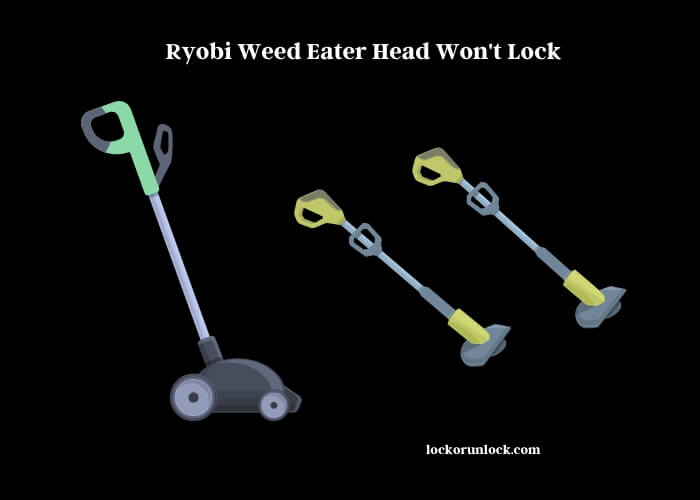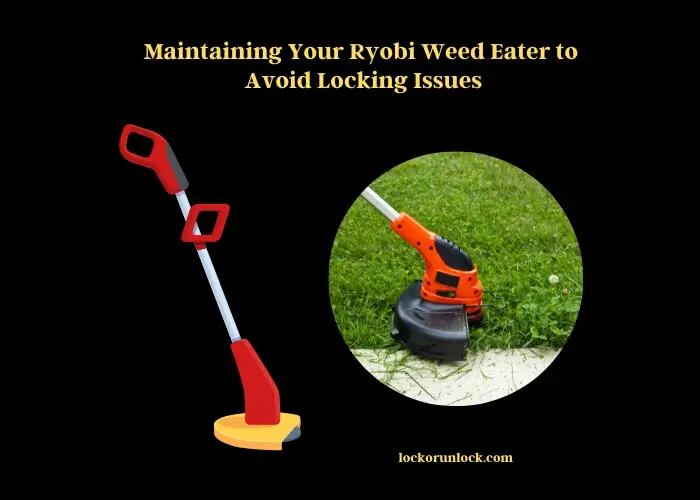The Ryobi weed eater head not locking is a common issue that stems from internal issues. Such problems can arise due to jamming or a malfunctioning mechanism within the device.
The internal components of the weed eater head, including the spool and line-feed, are critical for the device’s function. These are intricate parts where threads of the line are wound around the spool, allowing the weed eater to perform its cutting operation. With constant usage, these parts can experience wear-and-tear that might prevent the head from locking. Moreover, the threads can get tangled or jammed, leading to a malfunction in the mechanism.
A crucial part of the locking mechanism of the Ryobi weed eater head is the locking-pin. If the pin is not properly inserted or it is worn out, the head won’t lock. The pin must be secure in its position to ensure the smooth functioning of the device. Besides, any obstruction in the path of the locking-pin can hinder its movement, resulting in the head failing to lock.
Performing regular maintenance is key in preventing these issues. Regular checks and cleaning of the weed eater head, especially the spool and line-feed, can help identify and rectify potential problems early. Replacing the worn-out parts, including the locking-pin, can ensure the durability and efficient performance of your Ryobi weed eater.
Behind the Ryobi Weed Eater’s Design

Highlighting Features of Ryobi Weed Eaters
Ryobi is a brand synonymous with durability and efficiency in the outdoor tools market. Their weed eaters, also known as string trimmers, feature ergonomic designs, high-quality construction, and innovative technologies. From the powerful motor to the comfortable grip, every component of a Ryobi weed eater is crafted for optimum performance.
The Crucial Role of the Weed Eater Head
Located at the business end of the weed eater, the head is a vital component. The head houses the cutting string, which spins at high speed to cut through weeds and grass. A well-functioning head is paramount for the optimal operation of the tool, ensuring precision and speed in your gardening tasks.
How a Ryobi Weed Eater Head Locks
Structural Components of the Weed Eater Head
A weed eater head comprises several parts, including the housing, spool, cap, and locking mechanism. These components work in tandem to keep the head secure and allow the cutting string to spin unimpeded. Ryobi’s design ensures a robust and reliable locking mechanism, contributing to the weed eater’s overall efficiency.
Operating Principle of the Locking Mechanism
The locking mechanism in a Ryobi weed eater head is primarily responsible for keeping the spool in place during operation. A functional locking mechanism is essential for safety and performance. It holds the components securely, preventing wobbling or dislodging while the head spins at high speed.
Top Reasons for a Ryobi Weed Eater Head Not Locking
Various factors can cause a Ryobi weed eater head not to lock. These range from wear and tear to incorrect assembly or damaged components.
Common causes for a Ryobi weed eater head not locking and brief description
| Cause | Description |
| Wear and Tear | Normal usage over time can cause parts to degrade, affecting the locking mechanism. |
| Incorrect Assembly | Incorrectly assembling the head can lead to improper functioning of the lock. |
| Damaged Components | Physical damage to any part of the head can affect the overall functionality, including the lock. |
Diagnosis Steps for a Non-Locking Ryobi Weed Eater Head
Preparing for the Diagnostic Process: Safety Measures
Before commencing any diagnostic or repair activities on your Ryobi weed eater, it’s paramount to follow safety precautions. Disconnect the power supply, wear protective gear, and work in a well-lit, clean space. Safety should always come first in any repair process.
Initial Assessment: Visual Inspection and Functional Testing
Start your assessment by inspecting the weed eater head visually. Look for any apparent signs of damage or wear on the various components. Following this, conduct a functional test. Try to lock and unlock the head and observe any inconsistencies or difficulties.
Addressing Specific Locking Issues
Dealing with Worn-out Parts
Over time, parts of your Ryobi weed eater head, such as the locking mechanism, can wear out, leading to issues with the head not locking. This usually requires replacing the worn-out parts. Always ensure to buy compatible and high-quality replacement parts for longevity and optimal performance.
Rectifying Errors in Assembly
If your weed eater head is incorrectly assembled, it may not lock properly. In such a case, you’ll need to disassemble and reassemble the head properly, ensuring every part is in its correct position. This process might seem daunting, but with patience and the right guidance, you can get it done.
Remedying Damaged Components
Physical damage can also lead to a weed eater head not locking. If any parts of the head are damaged, you’ll need to replace them. Remember, using a weed eater with a damaged head can be dangerous, so never ignore this issue.
Steps to Assemble a Ryobi Weed Eater Head Correctly
Required Tools and Safety Guidelines
Before you begin, gather all the necessary tools. You’ll typically need a wrench and a screwdriver. Wear gloves to protect your hands and safety glasses to shield your eyes from any debris. Working in a well-lit, flat surface can make the process easier.
Step-by-step Assembly Instructions
Follow the user manual that comes with your Ryobi weed eater for detailed assembly instructions. Ensure you follow every step closely and double-check your work. Proper assembly is critical to the effective operation of the weed eater head.
Maintaining Your Ryobi Weed Eater to Avoid Locking Issues

Regular maintenance of your Ryobi weed eater can prevent issues like the head not locking. This includes tasks like cleaning the tool after use, regularly inspecting for any signs of wear or damage, and replacing parts as needed.
Essential maintenance tasks for your Ryobi weed eater and their frequency
| Maintenance Task | Frequency |
| Cleaning | After each use |
| Inspection for wear or damage | Monthly |
| Replacing worn-out parts | As needed |
Professional Assistance: Beyond DIY Repairs
Recognizing Complex Problems
While many problems with a Ryobi weed eater head not locking can be fixed at home, some issues may require professional help. If you’ve tried the above steps and the problem persists, it might be time to call a professional.
Seeking a Qualified Repair Technician
Look for a technician who specializes in weed eater repairs, preferably with experience in handling Ryobi products. They have the expertise to diagnose and fix complex problems efficiently and safely.
Replacing a Ryobi Weed Eater Head
Evaluating Replacement Over Repair
In some cases, it might be more cost-effective to replace the entire weed eater head than to repair it. This is especially true if multiple parts are worn out or damaged, or if the head is old.
Cost comparison of repair vs. replacement of a Ryobi weed eater head
| Option | Cost |
| Repair | Varies based on the severity of the problem and parts needed |
| Replacement | Depending on the model and source |
FAQs
How Can I Remove the Head from a Ryobi Weed Eater?
To remove the head from a Ryobi weed eater, you first need to disconnect the power source. Then, stabilize the device and find the head locking mechanism. Once located, you can usually depress it to unlock the head and rotate it counterclockwise to remove it.
Why Does My Ryobi Weed Eater Head Keep Falling Off?
If your Ryobi weed eater head keeps falling off, it’s likely due to a loose or damaged connection. Inspect the area where the head connects to the shaft, and tighten it if necessary. If any part appears worn out or damaged, you may need to replace it.
What Could Be Causing Problems with My Ryobi Weed Eater?
Problems with a Ryobi weed eater can be due to several factors, such as a worn-out line, a loose head, or a malfunctioning motor. In many cases, regular maintenance can prevent these issues. Always consult your user manual or a professional for specific troubleshooting advice.
How Do I Assemble the Head on a Ryobi Weed Eater?
Ryobi weed eater head assembly involves attaching the spool to the housing, fitting the cap, and then securing the head to the weed eater shaft. For precise instructions, refer to your Ryobi weed eater user manual as assembly steps can vary by model.
Can I Attach a Line Trimmer to My Ryobi Weed Eater?
Yes, many Ryobi weed eaters are designed to be compatible with various attachments, including line trimmers. To attach, align the connection on the trimmer with the one on the weed eater, then push and twist until it clicks into place.
How Can I Replace the Trimmer Line on My Ryobi Expand-It Weed Eater?
To replace the trimmer line on a Ryobi Expand-It weed eater, you need to first remove the spool from the head. Then, cut a new line, insert it into the spool, and wind it around as per the arrows on the spool. Finally, reinstall the spool into the head.
Does My Ryobi Gas Trimmer Head Work Differently from Electric Models?
The functionality of a Ryobi gas trimmer head is largely similar to that of an electric model, but there are a few differences. Gas trimmer heads are typically larger and more robust due to the increased power of gas models. Also, maintenance might slightly differ due to the gas engine.
Read more:
- Overcoming Locked Wheel & Key Issues in Your Subaru
- Double Beep Dilemma: Why Your Range Rover Won’t Lock
- Infiniti Door Lock Problems: Diagnosis, Solutions, and Maintenance
- Troubleshooting 2020 Chevy Silverado Door Lock Issues
- The Ins and Outs of Delayed Door Lock Systems
- Can Bolt Cutters Cut a Master Lock? Find Out Here!
